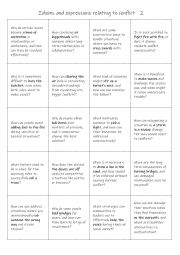
|
B1+-C1 Idioms and expressions relating to conflict 2
This is a speaking reinforcement activity to supplement the other worksheet I uploaded on 29/1/2025. Students working in pairs or small groups can either ask each other the questions or answer the question themselves.
Level: intermediate
Age: 12-100
Type:
Downloads: 118
|
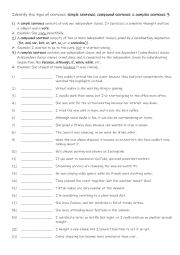
|
A2 Identify the type of sentence simple sentence, compound sentence & complex sentence 3
Students should learn to identify simple, compound, and complex sentences because it helps them write with more variety, organise ideas clearly, understand reading texts more easily, prepare for future learning, and communicate their thoughts more accurately. Each type is used 7 times. Answers on page 2.
Level: elementary
Age: 9-100
Type:
Downloads: 121
|
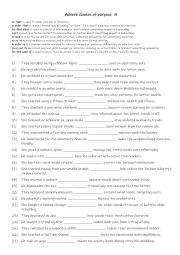
|
A2+-B1 9 adverb clauses of purpose 4
First, students need to familiarise themselves with the 9 adverbs and check their meaning. Then they read the sentences to see which one is needed to complete the sentence. Each word is used 3 times! Answers on page 2.
Level: elementary
Age: 9-100
Type:
Downloads: 121
|
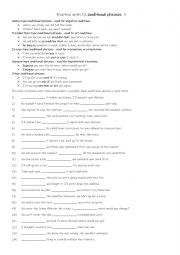
|
Practise with 12 conditional phrases 1
First, students need to familiarise themselves with the 12 conditional phrases and their meanings and use. Then they read the sentences to see which one is suitable to complete the gap-fill. Each conditional phrase is used 2 times! Answers on page 2.
Level: intermediate
Age: 10-100
Type:
Downloads: 122
|
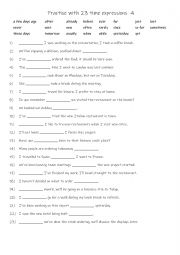
|
A2+-B1 Practise with 23 adverbs of time 4
Recognising these expressions improves listening and reading comprehension, enabling students to grasp stories, instructions, and conversations more effectively. First, students need to familiarise themselves with the 23 time expressions and their use. Then they read the sentences to work out which one is needed to complete the gap-fill. Answers on...
Level: elementary
Age: 10-100
Type:
Downloads: 112
|
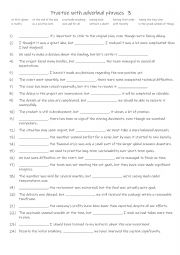
|
B1-C1 Practice with 12 adverbial phrases 3
Learning adverbial phrases are essential for effective and nuanced communication. These phrases allow students to organise ideas, express perspectives, and add emphasis or transitions in both spoken and written English. For instance, they can introduce initial impressions (at first glance), summarise a conclusion (at the end of the day), shift focu...
Level: intermediate
Age: 11-100
Type:
Downloads: 126
|
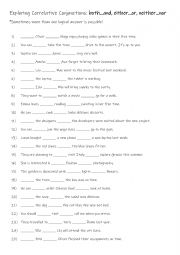
|
A2-B1 Exploring Correlative Conjunctions both...and, either...or, neither...nor 2
Students read the sentences and complete the gap-fill with the correct conjunctions. Answers on page 2.
Level: intermediate
Age: 10-100
Type:
Downloads: 118
|
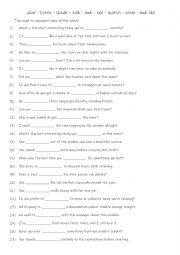
|
B1-B2 Confusing words Hear - listen - speak - talk - look - see - watch - seem - look like
Students familiarise themselves with the 10 verbs to see what is the difference in meaning. Then they read the sentences to see which verb is needed to complete the gap-fill. The students need to conjugate some of the verbs. Answers on page 2.
Level: intermediate
Age: 8-100
Type: worksheet
Downloads: 118
|
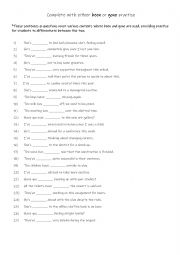
|
Complete with either been or gone practise
These sentences & questions cover various contexts where been and gone are used, providing practise for students to differentiate between the two. Students read the 27 sentences and questions to decide if the gap-fill exercise needs either been or gone to complete it. This worksheet is suitable for A2-B1 students. Answers on page 2.
Level: elementary
Age: 8-100
Type:
Downloads: 117
|
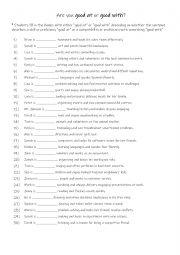
|
A2-B1 Are you good at or good with?
Students fill in the blanks with either good at or good with depending on whether the sentence describes a skill or proficiency good at or a compatibility or proficiency with something good with. Answers on page 2.
Level: intermediate
Age: 10-100
Type:
Downloads: 112
|












